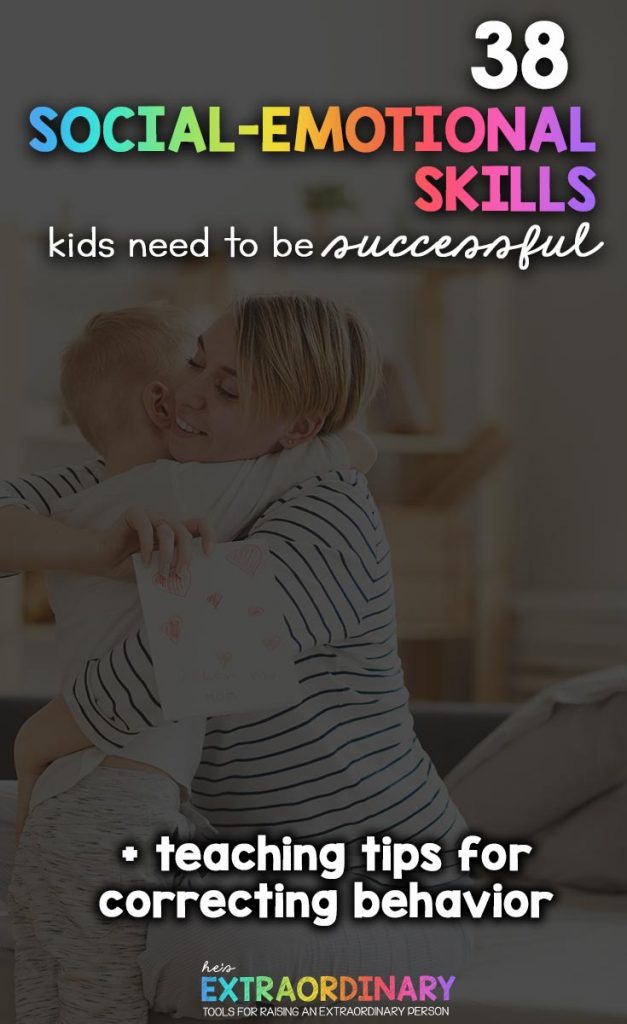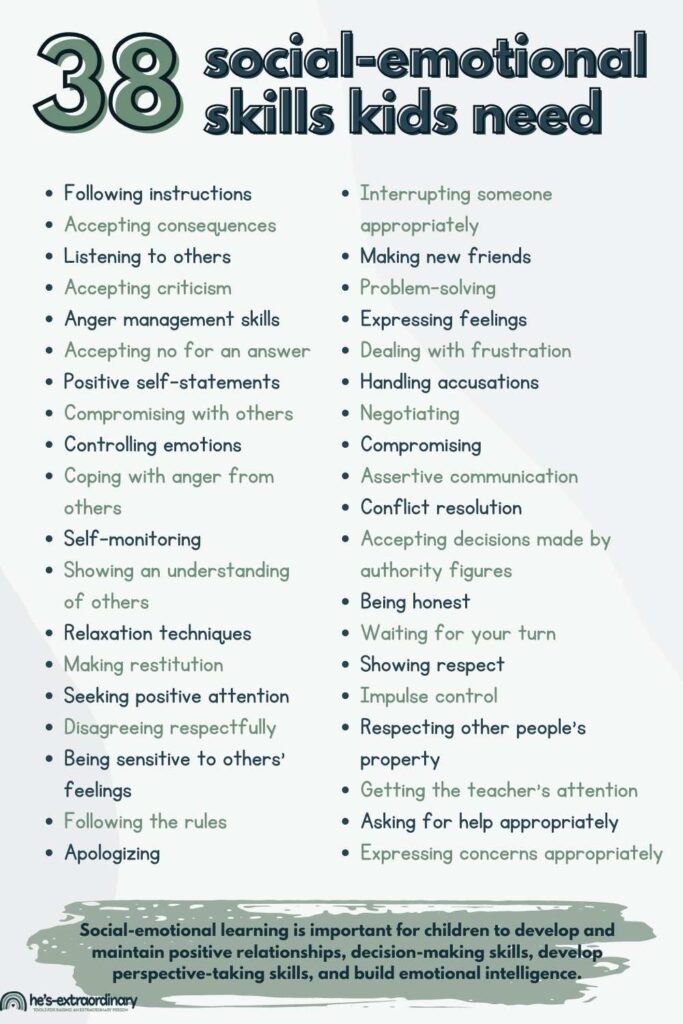38 Social-Emotional Skills Kids Need for Success + Teaching Tips
What’s inside this article: A list of 38 skills that are part of social-emotional learning and tips for how you can help teach your child social-emotional skills they’re struggling with.
Children are constantly learning from the world around them, developing a multitude of skills as they navigate through their life experiences.
Many skills seem to develop on their own, but that’s not exactly true. Your child actually learns these things by observing others, experiencing natural consequences, books, media, through interactions with peers, etc.
However, like some people struggle to learn certain academic skills, some people struggle to learn certain social-emotional skills.

Social-Emotional Learning Starts at Home
Social-emotional learning is important for children to develop and maintain positive relationships and decision-making skills, develop perspective-taking skills, and build emotional intelligence.
Kids are born with many intense emotions, but they aren’t born with the skills to respond to, express, or cope with these emotions.
This is why engaging in social-emotional learning at home is so important.
This article describes what social-emotional learning is, and how you can begin teaching these skills even in very early childhood.
Read: Social-Emotional Learning Begins at Home – Here’s How to Do it
Skill Deficits Don’t Mean Kids are Bad
Before we understood learning disabilities, people believed that kids who couldn’t read or couldn’t do math were stupid or lazy. But now we know their brain just learns differently.
For example. a child with dyslexia could be trying harder than anyone else to read at school and told they need to put in more effort – well the truth is they’re already putting in more effort than other children who are good readers. Plus, they’re not receiving any credit for their efforts!
Likewise, a child with behavior problems may be trying harder than the “good kid” to listen, but they aren’t successful because they haven’t yet developed the necessary skills.
Even if your child can do these skills sometimes, keep in mind that their emotional state can affect their ability to use those skills at certain times.
Have you ever been angry?
Think about how it becomes more challenging to communicate when you’re angry. Now, remember, that applies to kids with various skills, too.
Regardless of what your child struggles with, with the right support they can be successful. It just takes time and finding the right way of teaching for their learning style.
Targeting Individual Skills
As you read through these skills, make note of which ones you believe are difficult for your child.
In the same way, a teacher might target the nine times table; if that’s the one your child was struggling with, you can target and teach individual social-emotional skills too.
There are many different teaching strategies. You and your child’s teacher, guidance counselor, therapist etc may use a combination of these strategies to teach social-emotional skills.
- Modeling
- Social Stories
- Children’s books
- Role-Playing
- Coaching
- Creating specific opportunities to practice the skills
Social-Emotional Skills Children Need to Be Successful
There are some articles on the website that provide strategies for teaching specific skills. When that’s the case, I’ve linked directly to those articles for your convenience.
Note: You shouldn’t feel your child needs all these skills mastered. Many of these are skills that develop over your entire lifetime.
But as a parent or educator, you can continually work your child’s development in a meaningful way that will benefit their life.
For example, if even gentle criticism is very challenging for your child to handle, making the extra effort to teach them how to accept criticism can help reduce your child’s stress in that scenario.
You know your child best and are the best person to judge which skills are and are not appropriate for them and which teaching strategies are most helpful.
- Following instructions
- Accepting consequences
- Listening to others
- Accepting criticism
- Anger management skills
- Accepting no for an answer
- Positive self-statements
- Compromising with others
- Controlling emotions
- Coping with anger from others
- Self-monitoring
- Showing an understanding of others
- Relaxation techniques
- Making restitution
- Seeking positive attention
- Disagreeing respectfully
- Being sensitive to others’ feelings
- Following the rules
- Apologizing
- Interrupting someone appropriately
- Making new friends
- Problem-solving
- Expressing feelings
- Dealing with frustration
- Handling accusations
- Negotiating
- Compromising
- Assertive communication
- Conflict resolution
- Accepting decisions made by authority figures
- Being honest
- Waiting for your turn
- Showing respect
- Impulse control
- Respecting other people’s property
- Getting the teacher’s attention
- Asking for help appropriately
- Expressing concerns appropriately
Social Skills Digital Mega Bundle
98 pages of social narratives & visual supports for teaching social skills.
Teaching Missing or Lagging Social-Emotional Skills
Once you’ve identified which skills on the list your child needs to work on, you can begin planning how you’ll teach that skill.
For some of these skills, it may just be a matter of teaching the skill.
However, for others, it won’t just be about teaching them new skills but also correcting an inappropriate behavior they currently use.
Your goal will be to replace the inappropriate behavior with the new skill by using a combination of teaching, positive reinforcement, consequences, and feedback.
This should be a positive experience, not a punitive one.
Depending on your child’s age and abilities, you may decide this is something you plan and implement on your own, or you may decide to involve your child in the process.
Steps for Corrective Teaching
Choose A Skill
Choose a skill you want your child to learn and identify the negative behavior this skill will replace. During this step, be as specific as possible.
Keeping the skill too vague will make it too difficult to teach.
For example, in “respect,” this skill applies in many different situations, and it can look very different depending on the scenario. Instead, you might want to start by addressing a specific situation, such as speaking respectfully at the dinner table.
You can expand and generalize the skill later, but work in smaller steps for your child to succeed.
Talk to Your Child
If you’re involving your child in the process, sit down and talk to them at a time when they’re calm and receptive. Use non-threatening language, you don’t want them to feel like they’re in trouble.
For example, “I’ve noticed that sometimes it’s really hard for you to interact respectfully with others at the dinner table, and I was wondering if that’s something we could practice together?”
Proactive Teaching
Next, plan and then implement your proactive teaching strategies.
Decide how you’ll help your child learn the skill they’re missing. You can look for (or make your own) social stories about the skill or find children’s books on the topic, role-playing, etc.
There are often read-aloud stories and educational videos available on YouTube as well.
You should expect to go over the new skill many times. If your child struggles to learn social-emotional skills, they aren’t going to pick them up overnight. It will take time a repetition.
Preventative Prompt
A preventative prompt is just a brief reminder of the skill just before your child will need to use that skill.
“It’s almost dinner time. Remember, we are going to practice using our manners and being respectful.”
Give Feedback & Praise
It’s important to provide feedback to your child when they:
When you’re correcting behavior, keep the feedback short and direct. If your child feels like they’re being nagged or chastised, they are more likely to become defensive.
When you notice your child attempting to use the skill, give feedback and praise by:
Correcting Inappropriate Behavior
This is for those moments when your child doesn’t use or attempt the skill you’re teaching, engaging in the behavior you’re trying to correct.
Keep in mind that your child hasn’t yet mastered the social-emotional skills you’re working on. Assume the misbehavior is not because they don’t want to listen to you but because they don’t have the necessary skills.
The consequence keeps the message clear that their behavior is not acceptable but the restorative option puts the focus on teaching the right behavior, not punishing for their mistakes.
Tips for Successful Teaching


